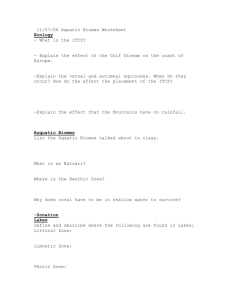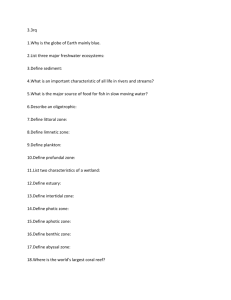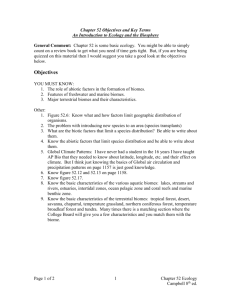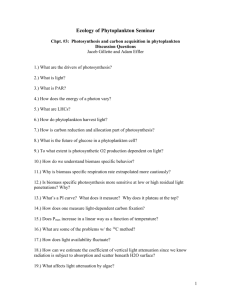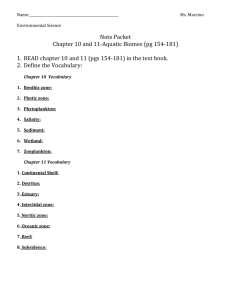AQUATIC BIOMES
advertisement
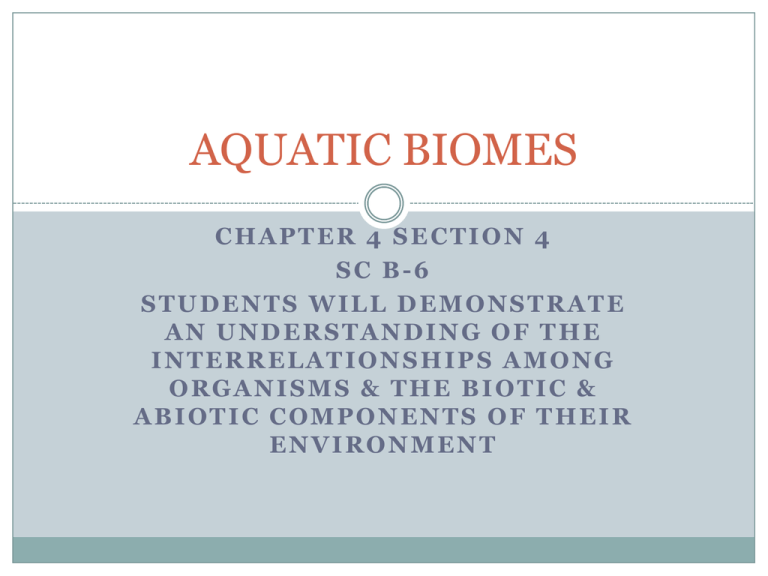
AQUATIC BIOMES CHAPTER 4 SECTION 4 SC B-6 STUDENTS WILL DEMONSTRATE AN UNDERSTANDING OF THE INTERRELATIONSHIPS AMONG ORGANISMS & THE BIOTIC & ABIOTIC COMPONENTS OF THEIR ENVIRONMENT Aquatic Biomes charaterized primarily by their physical environment rather than be climate often layered with regard to light penetration temperature community structure Zonation in Aquatic Biomes light absorbed by water itself + photosynthetic organisms so…light intensity decreases rapidly with depth Photic Zone: sufficient light for photosynthesis Aphotic Zone: little light penetrates Pelagic Zone = photic zone + aphotic zone Zonation in Aquatic Biomes Abyssal Zone: 2,000 – 6,000 m deep Benthic Zone: the bottom of all aquatic biomes, shallow or deep Benthos: communities of organisms that live in sand & sediments of the benthic zone More Definitions Detritus: dead organic material that “rains” down from photic zone; food source for benthos Thermocline: narrow layer of water where there is an abrupt temperature change separates the more uniformly warm upper layer from the uniformly cold deeper water many temperate lakes undergo a semiannual mixing of their water Lakes lake environment generally classified on basis of 3 physical criteria: 1. light penetration photic / aphotic 2. distance from shore / depth of water littoral / limnetic 3. open water / bottom pelagic / benthic Lakes standing bodies of water range from ponds a few square meters in area to lakes covering thousands of square kilometers Lakes: Oligotrophic Lakes: Eutrophic Lakes: Photosynthetic Organisms Littoral Zone: shallow, well-lit waters close to shore rooted & floating aquatic plants Limnetic Zone: waters too deep to support rooted plants phytoplankton, including cyanobacteria Phytoplankton Lakes: Heterotrophs Limnetic Zone: small, drifting heterotrophs or zooplankton (graze on phytoplankton) Benthic Zone: assorted invertebrates (species depends on O2 content) Fishes live in all zones that have sufficient O2 Zooplankton Wetlands habitat that is inundated by water (at least part of the year) & supports plants adapted to watersaturated soil due to high organic production by plants & decomposition by microbes: water & soil of wetlands periodically low in dissolved O2 *high filter capacity: both nutrients & pollutants Wetlands: Autotrophs among most productive biomes in world water-saturated soils great for plants Lily pads Cattails Sedges Tamaracks Black spruce Wetlands: Heterotrophs diverse community of invertebrates, birds, reptiles, amphibians, and mammals Herbivores: crustaceans aquatic insect larvae muskrats Carnivores: dragonflies frogs alligators herons Streams: Physical Environment most prominent characteristic: their current stratified into vertical zones Streams: Physical Environment Headwaters: generally cold, clear turbulent, & swift Downstream: generally warmer more turbid Estuary a transitional area between river & sea when high tide: salt water flows up estuary channel higher density sea water stays below lesser density freshwater Estuary: Chemical Environment salinity varies from that of freshwater sea water & with rise & fall of tides nutrients from rivers make estuaries some of most productive biomes Estuary: Photosynthetic Organisms saltmarsh grasses & algae (including phytoplankton) are major producers Estuary: Heterotrophs abundant #’s of worms, oysters, crabs, & many fish many invertebrates & fishes use estuaries as breeding grounds crucial feeding grounds for birds & some marine mammals Intertidal Zones are periodically submerged & exposed by the tides, 2x daily on most marine shores upper zones exposed to air for longer periods greater variation in temp & salinity changes in physical conditions from upper to lower zones limits the distribution of many organisms to particular strata Intertidal Zones: Chemical Environment O2 & nutrient levels generally high & renewed with each turn of the tides Intertidal Zone: Photosynthetic Organisms high diversity & biomass of attached marine algae inhabit rocky intertidal zones much lower diversity & biomass in sandy intertidal zones with vigorous wave action sandy intertidal zones in protected bays or lagoons have rich beds of grass & algae Intertidal Zone: Heterotrophs animals here have multiple structural adaptations rocky areas: ways to attach to hard surfaces sandy areas: many bury themselves feed on what tides bring them Ocean Pelagic Zone open blue waters mixed constantly by wind & ocean currents photic zone extends deeper here (water is clearer) Oceanic Pelagic Zone: Chemical Environment O2 levels generally high nutrient levels generally lower than in coastal waters tropical oceans: thermally stratified all year temperate & hi-latitude oceans have spring & fall turnover so generally nutrients renewed in photic zone Oceanic Pelagic Zone: Geologic Features covers ~70% Earth’s surface average depth = 4,000 m deepest point: 10,000 m Pelagic Zone: Photosynthetic Organisms phytoplankton (including photosynthetic bacteria) dominate due to vast area this zone covers: ~50% of all photosynthesis on Earth by them Pelagic Zone: Heterotrophs zooplankton most abundant group in this zone graze on phytoplankton includes: protists worms copepods shrimp-like krill jellies small larvae of invertebrates Pelagic Zone: Heterotrophs also include free-swimming animals: large squid fishes sea turtles marine mammals Coral Reefs formed largely from the calcium carbonate skeletons of corals in photic zone of relatively stable tropical marine environments with high water clarity sensitive to temps < 18 – 20° & > 30°C found in deep seas 200 -1,500 m deep as much diversity as shallow reef Deep Sea Coral Reef Shallow Coral Reef Coral Reef: Chemical Environment require high O2 levels Coral Reefs: Photosynthetic Organisms unicellular algae live w/in tissues of corals in mutualistic relationship: provides corals with organic molecules diverse multicellular red & green algae growing on reef also photosynthesize Coral Reef: Heterotrophs dominant heterotroph: corals are a diverse group of cnidarians also high diversity of fishes & invertebrates overall nearly as diverse as tropical rainforest

